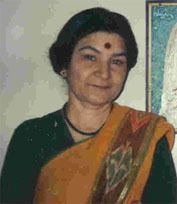Nationality Indian Doctoral advisor T.R. Sheshadri Died June 4, 2001, Hyderabad | Institutions IIT Kanpur Name Darshan Ranganathan Alma mater University of Delhi Thesis 1967 | |
 | ||
Born June 4, 1941 ( 1941-06-04 ) Notable awards Fellow of the Indian Academy of Sciences; Third World Academy of Sciences Award in Chemistry, 1999; Senior Research Scholarship of the Royal Commission for the Exhibition of 1851, A.V. Rama Rao Foundation Award, Jawaharlal Nehru Birth Centenary Visiting Fellowship, and Sukh Dev Endowment Lectureship. Spouse S. Ranganathan (m. 1970) Institution Indian Institute of Technology Kanpur Books Art in biosynthesis, Further challenging problems, Challenging problems in organic | ||
Darshan Ranganathan (June 4, 1941 – June 4, 2001) was an organic chemist from India who was known for her work in bio-organic chemistry, including "pioneering work in protein folding." She was also recognized for her work in "supramolecular assemblies, molecular design, chemical simulation of key biological processes, synthesis of functional hybrid peptides and synthesis of nanotubes."
Contents
Biography
Darshan Ranganathan was born on June 4, 1941 to Vidyavati Markan and Shanti Swarup. She was educated in Delhi and received a Ph.D. in chemistry from Delhi University in 1967. First hired as a lecturer, she became head of the Chemistry Department at Miranda College, Delhi, and went on to receive an 1851 Research Fellowship from the Royal Commission for the Exhibition of 1851, to enable her to conduct postdoctoral work at Imperial College London with Professor D.H.R. Barton.
In 1970, she began research at the Indian Institute of Technology, Kanpur (IIT Kanpur). In that year, she married S. Ranganathan, with whom she would go on to author Challenging problems in organic reaction mechanisms (1972), Art in biosynthesis: the synthetic chemist's challenge (1976), and Further challenging problems in organic reaction mechanisms (1980)—as well as editing an ongoing series titled "Current Organic Chemistry Highlights".
She continued her research at IIT Kanpur on the basis of fellowships. Unwritten rules prevented her from joining the faculty because her husband was already a member.
She began work at Regional Research Laboratory, Trivandrum in 1993, and at IICT, Hyderabad in 1998., where she became Deputy Director. During these years, she conducted ongoing collaborations with Isabella Karle at the U.S. Naval Research Laboratory.
Darshan Ranganathan was diagnosed with breast cancer in 1997, and died on her 60th birthday, in 2001.
The biennial "Professor Darshan Ranganathan Memorial Lecture", which is to be "delivered by a woman scientist who has made outstanding contributions in any field of Science and Technology" was established in her memory by her husband, in 2001.
Work
Ranganathan's special passion was reproducing natural biochemical processes in the laboratory. She created a protocol which achieved the autonomous reproduction of imidazole, an ingredient of histadine and histamine with pharmaceutical importance. She also developed a working simulation of the urea cycle. As her career developed, she became a specialist in designing proteins to hold a wide variety of different conformations and designing nanostructures using self-assembling peptides.
